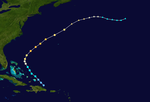1952 Atlantic hurricane season
| 1952 Atlantic hurricane season |

Season summary map
|
| Seasonal boundaries |
| First system formed |
February 3, 1952 |
| Last system dissipated |
November 30, 1952 |
| Strongest storm |
|
| Name |
Fox |
| • Maximum winds |
145 mph (230 km/h) |
| • Lowest pressure |
934 mbar (hPa; 27.58 inHg) |
| Seasonal statistics |
| Total depressions |
11 |
| Total storms |
11 |
| Hurricanes |
5 |
Major hurricanes
(Cat. 3+) |
2 |
| Total fatalities |
47 |
| Total damage |
$13.75 million (1952 USD) |
|
|
Atlantic hurricane seasons
1950, 1951, 1952, 1953, 1954
|
| Tropical storm (SSHWS) |
|
|
| Duration |
February 3 – February 4 |
| Peak intensity |
70 mph (110 km/h) (1-min) ≤ 990 mbar (hPa) |
| Category 2 hurricane (SSHWS) |
|
|
| Duration |
August 18 – September 3 |
| Peak intensity |
100 mph (155 km/h) (1-min) 980 mbar (hPa) |
| Tropical storm (SSHWS) |
|
|
| Duration |
August 27 – August 28 |
| Peak intensity |
50 mph (85 km/h) (1-min) 1000 mbar (hPa) |
| Category 2 hurricane (SSHWS) |
|
|
| Duration |
August 31 – September 8 |
| Peak intensity |
110 mph (175 km/h) (1-min) 969 mbar (hPa) |
| Tropical storm (SSHWS) |
|
|
| Duration |
September 8 – September 11 |
| Peak intensity |
50 mph (85 km/h) (1-min) ≤ 999 mbar (hPa) |
| Category 3 hurricane (SSHWS) |
|
|
| Duration |
September 24 – September 28 |
| Peak intensity |
120 mph (195 km/h) (1-min) ≤ 958 mbar (hPa) |
| Tropical storm (SSHWS) |
|
|
| Duration |
September 24 – September 30 |
| Peak intensity |
70 mph (110 km/h) (1-min) 998 mbar (hPa) |
| Tropical storm (SSHWS) |
|
|
| Duration |
September 25 – September 30 |
| Peak intensity |
45 mph (75 km/h) (1-min) ≤ 1000 mbar (hPa) |
| Category 2 hurricane (SSHWS) |
|
|
| Duration |
October 6 – October 11 |
| Peak intensity |
105 mph (165 km/h) (1-min) 968 mbar (hPa) |
The 1952 Atlantic hurricane season was the last Atlantic hurricane season to name tropical cyclones using the phonetic alphabet. It was a near normal Atlantic hurricane season, although it was the least active since 1946. The season officially started on June 15; however, a pre-season unnamed storm formed on Groundhog Day, becoming the only storm on record in the month of February. The other six tropical cyclones were named using the Joint Army/Navy Phonetic Alphabet, the first of which formed on August 18. The final storm of the season dissipated on October 28, two and a half weeks before the season officially ended on November 15.
Four of the tropical cyclones made landfall during the season, the first being the February tropical storm that crossed southern Florida. The first hurricane, named Able, struck South Carolina with winds of 100 mph (160 km/h), causing heavy damage near the coast and widespread power outages. It moved up most of the East Coast of the United States, leaving 3 deaths and widespread damage. As a developing tropical cyclone, Hurricane Charlie caused damaging flooding and landslides in southwest Puerto Rico. The final and strongest of the season, Hurricane Fox, struck Cuba with winds of 145 mph (233 km/h); it killed 40 people and left heavy damage, particularly to the sugar crop, reaching $10 million (1952 USD, $90.2 million 2017 USD).
On February 2, a non-frontal low formed in the western Caribbean Sea two months after the end of the hurricane season. It moved quickly north-northwestward and acquired gale-force winds as it brushed the northern coast of Cuba. Early on February 3, the storm struck Cape Sable, Florida and quickly crossed the state. The Miami National Weather Service office recorded a wind gust of 68 mph (110 km/h) during its passage. The winds damaged windows and power lines, catching residents and tourists off-guard. The cyclone also dropped 2–4 inches (50–100 mm) of precipitation along its path, causing crop damage in Miami-Dade County.
...
Wikipedia













